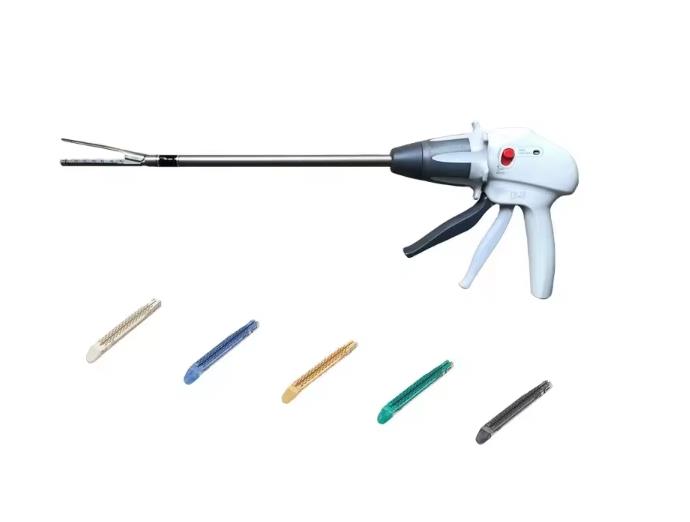endoscopic linear cutter reloads component
Endoscopic linear cutter reloads typically consist of several key components that work together to cut and staple tissue during surgical procedures. These components may vary slightly depending on the specific manufacturer and model, but they generally include:

Cartridge: The cartridge contains the staples that are used to secure the tissue after it has been cut. It is typically pre-loaded with a specific number of staples depending on the size of the reload and the surgical application.
Knife Blade: The knife blade is responsible for cutting the tissue during the surgical procedure. It is usually located in the center of the cartridge and is deployed when the cutter is activated.
Anvil: The anvil is the component of the reload that interacts with the knife blade to cut and staple the tissue. It is positioned opposite the knife blade and helps to form the staples as they are deployed.
Alignment Guides: Alignment guides are often included in the reload to ensure proper alignment of the tissue between the cartridge and the anvil. This helps to ensure accurate cutting and stapling and reduces the risk of misfires or incomplete closures.
Firing Mechanism: The firing mechanism is the part of the reload that activates the knife blade and deploys the staples. It is usually connected to a handle or trigger that is operated by the surgeon during the surgical procedure.
Safety Features: Many endoscopic linear cutter reloads include safety features such as sensors or indicators to help prevent misfires or incomplete closures. These features help to enhance the safety and reliability of the device during surgery.
Disposable Housing: The reload is typically housed in a disposable casing or housing that is designed to be inserted into the endoscopic or laparoscopic instrument. Once the reload has been used, the entire housing is disposed of to prevent cross-contamination between patients.
These components work together to facilitate precise tissue cutting and stapling during surgical procedures, helping to reduce operating time, minimize blood loss, and promote faster patient recovery.

Endoscopic linear cutter reloads are utilized in various surgical procedures, particularly those performed laparoscopically or endoscopically. Here are some common applications:
Gastrointestinal Surgery: Endoscopic linear cutter reloads are frequently employed in gastrointestinal surgeries such as gastric bypass surgery, sleeve gastrectomy, and bowel resection. These procedures involve cutting and stapling the stomach or intestines to modify their structure or remove diseased tissue.
Thoracic Surgery: In thoracic surgery, endoscopic linear cutter reloads are used for procedures like lung resection, lobectomy, or esophagectomy. They facilitate precise cutting and stapling of lung tissue or the esophagus, reducing bleeding and promoting faster healing.
Bariatric Surgery: Bariatric procedures, aimed at weight loss and treating obesity-related conditions, often require the use of endoscopic linear cutter reloads. These reloads are utilized to create gastric pouches or to modify the anatomy of the stomach and intestines to reduce the amount of food intake or nutrient absorption.
Colorectal Surgery: Endoscopic linear cutter reloads are commonly employed in colorectal surgeries, including colectomy, sigmoidectomy, and rectal resection. They assist in removing segments of the colon or rectum while simultaneously sealing the cut edges to prevent leakage and reduce the risk of infection.
Hepatobiliary Surgery: In procedures involving the liver, gallbladder, or bile ducts, endoscopic linear cutter reloads are used for resections, such as hepatectomy or cholecystectomy. They enable precise cutting and stapling of liver tissue or bile ducts, minimizing blood loss and ensuring secure closures.
Urological Surgery: Endoscopic linear cutter reloads find applications in urological surgeries like nephrectomy or partial nephrectomy, where they aid in cutting and stapling kidney tissue. They are also used in procedures involving the bladder or ureters for tissue dissection and closure.
Overall, endoscopic linear cutter reloads are versatile tools used across various surgical specialties for their ability to facilitate precise tissue cutting and stapling, minimize blood loss, reduce operative time, and enhance patient outcomes in minimally invasive surgeries.